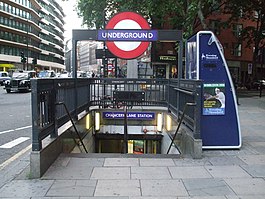Chancery Lane tube station
| Chancery Lane |
|
|---|---|

Northeastern entrance
|
|
|
Location of Chancery Lane in Central London
|
|
| Location | Holborn |
| Local authority | London Borough of Camden |
| Managed by | London Underground |
| Number of platforms | 2 |
| Fare zone | 1 |
| London Underground annual entry and exit | |
| 2012 |
|
| 2013 |
|
| 2014 |
|
| 2015 |
|
| Key dates | |
| 30 July 1900 | Opened |
| Other information | |
| Lists of stations | |
| WGS84 | 51°31′05″N 0°06′40″W / 51.518°N 0.111°WCoordinates: 51°31′05″N 0°06′40″W / 51.518°N 0.111°W |
|
|
|
Chancery Lane is a London Underground station in Holborn, central London. It opened in 1900 and takes its name from the nearby Chancery Lane.
The station is on the Central line, between St. Paul's and Holborn stations, within fare zone 1.
It is located at the junction of High Holborn, Hatton Garden and Gray's Inn Road, with subway entrances giving access to the ticket office under the roadway.
The station was opened by the Central London Railway (CLR) on 30 July 1900. The current station entrance is not the original. The original, disused station building is on the north side of High Holborn at Nos. 31-33, approximately 400 feet (122 m) to the west, closer to High Holborn's junction with Chancery Lane. Originally, provided with four lifts between ground and platform levels, the station was rebuilt in the early 1930s to operate with escalators. It was not possible to construct the inclined escalator shaft between the platforms and the existing entrance and so a new sub-surface ticket hall was constructed below the road junction. The new station entrance came into use on 25 June 1934. The old entrance building became redundant and, in recognition of the location of the new entrance, the station was renamed Chancery Lane (Gray's Inn), although the suffix subsequently fell out of use.
When the CLR excavated the running tunnels it routed them to avoid passing under surface buildings in order to limit the risk to surface buildings from vibration. At Chancery Lane, the tunnels are placed with the eastbound tunnel above the westbound one.
...
Wikipedia

